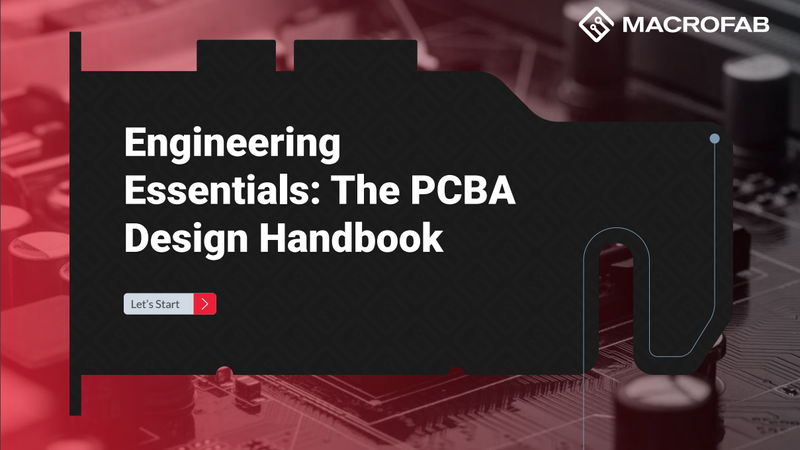Engineering Essentials: The PCBA Design Handbook
This 75-page e-book will provide you with the design skills to develop exceptional PCBAs that not only meet but surpass their intended objectives.
This article was first published on
www.macrofab.comTo excel in the fast-paced electronics industry, you need not just adaptability, but a cultivated expertise to discern the far-reaching impact of your design decisions. This eBook is your key to building such expertise.
"Engineering Essentials: The PCBA Design Handbook" equips you with the skills necessary to create exceptional PCBAs that consistently surpass expectations while keeping to stringent deadlines and budgets. From the basic principles of PCBA design to the most sophisticated techniques and best practices, this 75-page resource is your secret weapon to conquer even the most intricate design challenges.
Dive into the insightful chapters of our eBook and uncover:
Designing for Manufacturability: Master techniques to optimize your designs, streamline manufacturing processes, and effectively reduce costs.
Designing for Reliability: Learn the art of crafting robust PCBAs that thrive in harsh environments and offer unwavering performance.
Designing for Testability: Incorporate efficient built-in testing methods to accelerate production and enhance fault detection.
Designing for Compliance: Navigate the roadmap to ensure your designs comply with industry regulations and standards effortlessly.
Designing for EMC Compliance: Delve into the principles of electromagnetic compatibility and effectively minimize interference in your PCBA designs.
Designing for PCBA Lifespan: Unearth strategies to extend the life and performance of your PCBAs through smart design choices.
Begin your reading journey today, and harness the full spectrum of your electrical engineering potential today.
Here is the first section:
Designing for Manufacturability: Design Techniques and Best Practices
Design complexity is a daily reality for most PCBA designers, making their jobs increasingly difficult and challenging. This complexity extends beyond design, leading to intricate manufacturing hurdles.
Selecting a contract manufacturer that aligns with your design needs is crucial, as every product is unique and quality hinges on a compatible factory. A mismatch can result in manufacturing issues that can persist long after product shipment, causing unfulfilled warranty expectations, financial strain, or even loss of market share.
Design is a crucial element in the manufacturing and assembly process, and implementing effective strategies can make all the difference. While “design for manufacturability” (DFM) is a known concept, it is sometimes underappreciated or underutilized by electrical engineers.
Design for Manufacturability (DFM) is a proactive approach to designing products that can be consistently manufactured by the designated supply chain with minimal defects. A DFM approach combines best practices with a keen awareness of supply chain limitations, and it can improve the efficiency and quality of manufacturing.
By embracing DFM in the design process, electrical engineers can sidestep common problems like high production costs, low yields, extended lead times, and component shortages that tend to surface when DFM is neglected.
The purpose of this section is to provide electrical engineers with a deeper understanding of PCBA design guidelines and DFM best practices.
Best Practices for PCBA Design
To create high-quality, cost-effective, and easily manufactured PCBAs, it’s essential to adhere to certain design guidelines that are critical for manufacturability. These include
Component Placement and Selection
Choosing the right components for your PCBA is crucial for long-term reliability and performance. When selecting components, be sure to:
- Opt for standard components: Avoid unique or rare components, which may lead to higher costs, limited supplier competition, and increased supply chain disruptions. Standard components are more costeffective, have a proven track record, and have shorter lead times for better on-time product delivery.
- Conduct a Bill of Materials (BOM) analysis: A streamlined BOM can help reduce manufacturing costs. Fewer parts result in less purchasing activity, lower inventory needs, simplified inspections, and easier testing protocols. Careful creation and review of the BOM are essential to achieve this.
- Use multi-functional parts: Choose components that serve multiple purposes, such as a cover or base plate that also functions as a heat sink.
- Account for Moisture Sensitivity Level (MSL): Identify the MSL for all components and ensure the exposure time on the production floor is controlled. This helps prevent moisture-induced damage to sensitive components.
Improve PCBA Design with Lean Processes
As you tackle your PCBA design, remember to prioritize efficiency. Remove any unnecessary steps or elements that don’t contribute to your product’s overall quality or function. By simplifying the supply, fabrication, and assembly processes, you’ll not only increase accuracy and speed but also make your PCBA easier to manufacture.
- Use consistent traces: Use consistent trace widths and avoid overly complex routing patterns to facilitate a smooth and easy manufacturing and inspection process
- Optimize component placement: Choose careful component placement to minimize trace lengths and reduce the chance of signal interference
- Collaborate with manufacturers: Engage in early and ongoing communication with your CM to ensure design compatibility and address potential issues to improve and enhance manufacturability.
Optimize Trace Routing and Layout
Some key aspects to consider while optimizing trace routing and layout are:
- Trace Widths and Spaces: Choose trace widths and spaces according to the guidelines provided by IPC-2221 to ensure the efficient distribution of electrical signals and reduce signal interference.
- Layer Stackup: Design a balanced layer stack-up that promotes efficient signal routing and thermal management, considering factors such as signal integrity and power distribution.
- Routing Techniques: Implement appropriate routing techniques, such as using differential pairs, controlled impedance traces, and avoiding 90-degree angles, to maintain signal integrity and reduce the possibility of electromagnetic interference (EMI).
- Ground and Power Planes: Design solid ground and power planes to provide adequate electrical and thermal performance while minimizing noise and crosstalk.
- Design for Signal Integrity: Consider factors such as trace impedance, trace length matching, and proper termination to ensure the signals maintain integrity throughout the circuit.
Get the complete Engineering Essentials: The PCBA Design Handbook now.
